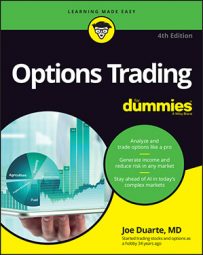Market risks
For the most part, market risks are out of your control. Of course you know the risk that the markets are bound to rise and fall, but understanding the risks you face when they do helps you manage your money better. Three key risks that you can manage as a trader are- Inflation risk: This describes the risk that your money won’t grow fast enough to exceed the cost increases caused by inflation. Basic goods and services such as housing, clothing, medical expenses, and food increase in price each year. If you invest in monetary vehicles that don’t keep pace with inflation, you actually end up losing money. Although inflation is a risk that stock traders rarely consider, it nevertheless impacts investors who are risk‐averse.
- Marketability risk: This risk relates to the liquidity of your investments. If you’re restricted from selling an investment when you want to do so, your target selling point is irrelevant. For most stock traders, this factor isn’t an issue, but if, for example, you choose to invest in a small company whose stock isn’t traded on one of the major exchanges, you risk not being able to close your position when the time is right. Many small‐cap stocks or penny stocks with low trading volume can also suffer from low liquidity that affects your ability to sell.
- Currency translation risk: Currency translation refers to disparities in trading stocks of companies in foreign countries. It’s only a factor when you trade foreign stocks because you then must be concerned with fluctuations between the values of your local currency and the currency in the country where the company is located. Even if the stock increases in price, you can still lose money based on the currency exchange rate. If the value of your currency falls against the other currency, your investment can be worth less when you convert it back.
Investment risks
Investment risks relate directly to how you invest your money and manage your entry and exit trades. Two critical risks you must manage are- Opportunity risk: This kind of risk involves balancing your trade‐offs. When you trade, you establish a position that ties up money that otherwise can be used elsewhere. After you choose a stock and buy it, you lose the opportunity to invest that capital in another stock or fund until you trade out of the first position. Essentially, you can miss other opportunities while your money is tied up in another position.
- Concentration risk: This kind of risk happens when you put too many eggs in one basket. You may think you’ve found the miracle stock that’s going to make you a millionaire, so you decide to invest a huge portion of your principal into that one position. By concentrating so much of your money on one investment, you also disproportionally expose yourself to the risks associated with that one specific investment. The less diversified your portfolio, the higher your concentration risk.
Trading risks
Risks that are unique to trading increase simultaneously with increases in trading volume. Day traders and swing traders often see a greater impact caused by these risks than do position traders or long‐term investors, but all market participants should be aware of them. Risks associated with trading are- Slippage risk: This risk considers the hidden costs associated with every transaction. Each time you enter or exit a position, your account balance shrinks by a small amount due to the stock’s bid‐ask spread. Buy orders are executed at the ask price (the lowest price available for the stock that you want), while sell orders are executed at the bid price (the highest price someone is willing to pay for shares you own). Unfortunately, the bid price is always less than the ask price. The difference between the two is referred to as the stock’s bid‐ask spread.
For example, if the current quote for a stock is $20.50/$20.55, a buyer would pay the ask price of $20.55, while a seller would receive the bid price of $20.50. If you bought one share of the stock and then immediately sold it, you would instantly lose $0.05 on the trade. Although you can mitigate bid‐ask problems by using limit orders, doing so subjects you to the risk that your order won’t get filled. The amounts for each trade may at first seem small, but as your trading volume increases, so do the amounts you lose to slippage.
- Poor execution risk: This problem occurs whenever your broker has a difficult time filling your order, which can result from any number of factors, including fast market conditions, poor availability of stock, and the absence of other buyers and sellers. The result is always the same: The price you expect differs from the price you actually receive. Although you can mitigate this problem to a degree by using limit orders, you still risk the stock trading through your limit price, preventing your order from being filled at all.
- Gap risk: This risk comes into play whenever a break in trading occurs. Sometimes a stock opens at a price significantly higher or lower than its previous close. When this happens, the stock can trade right through your target exit price or your stop.
For example, a stock may close at $25 a share today and open tomorrow morning at $20. If you’ve entered a stop order to exit you out of the trade at a price of $24, the order is likely to be filled at the $20 opening price or lower, clearing your stop entirely. Price gaps created in this way occur most often at the open. Although more rare, a gap also can occur during the trading day, perhaps if surprising news is reported or after trading has been temporarily halted.

